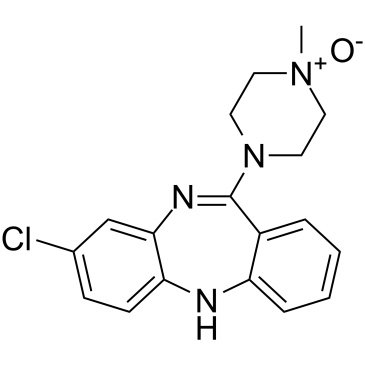| DC73426 |
F17464
|
F17464 is a dopamine D3 receptor preferential antagonist exhibiting high affinity for human dopamine receptor subtype 3 (hD3) (Ki=0.17 nM) and 5-HT1a (Ki=0.16 nM) and a >50 fold lower affinity for the human dopamine receptor subtype 2 short and long form (hD2s/l) (Ki=8.9 and 12.1 nM, respectively).
F17464 is a D3 receptor antagonist, 5-HT1a receptor partial agonist.
F17464 blocks ketamine induced morphological changes, an effect D3 receptor mediated, in human dopaminergic neurons. F17464 increases dopamine release in the rat prefrontal cortex and mouse lateral forebrain-dorsal striatum and seems to reduce the effect of MK801 on % c-fos mRNA medium expressing neurons in cortical and subcortical regions.
F17464 also rescues valproate induced impairment in a rat social interaction model of autism, with dose range 0.32-2.5 mg/kg i.p. in both rats and mice |
| DC73421 |
ASP4345
|
ASP4345 (ASP-4345) is a potent, selective positive allosteric modulator of the dopamine type 1 (D1) receptor that selectively binds to, and enhances the activity of, D1 receptors. |
| DC72808 |
UCM-1306
|
UCM1306 is a potent and orally active human dopamine D1 receptor allosteric modulator (PAM). UCM-1306 increases the endogenous dopamine (DA) maximal effect both in human and mouse D1 receptors. UCM-1306 is not only for improving motor symptoms but also for addressing the key comorbid cognitive impairment associated with long-term Parkinson’s disease (PD). |
| DC47683 |
Mesdopetam hemitartrate
|
Mesdopetam (IRL790) hemitartrate is a dopamine D3 receptor antagonist (Ki=90 nM; IC50=9.8 μM for human recombinant D3 receptor) with psychomotor stabilizing properties. Mesdopetam hemitartrate is used for the research of motor and psychiatric complications in Parkinson disease. |
| DC47270 |
(S)-Amisulpride
|
(S)-Amisulpride (Esamisulpride) is a potent dopamine D2/D3 receptor antagonist. (S)-Amisulpride is an antagonist at the 5-HT7 receptor with a KI of 900 nM. (S)-Amisulpride has antipsychotic and antidepressant effects. |
| DC46840 |
Mesdopetam
|
Mesdopetam (IRL790) is an orally active and low toxicity dopamine D3 receptor antagonist. Mesdopetam can be used for the research of Parkinson's disease (PD). |
| DC43970 |
NGB 2904 hydrochloride
|
NGB 2904 hydrochloride is a potent, selective, orally active and brain-penetrated antagonist of dopamine D3 receptor, with a Ki of 1.4 nM. NGB 2904 hydrochloride shows selectivity for D3 over D2, 5-HT2, α1, D4, D1 and D5 receptors (Kis=217, 223, 642, >500 |
| DC8859 |
SKF38393 HCl
|
SKF38393 HCl is a selective dopamine D1/D5 receptor agonist. |
| DC12316 |
PD-168077 maleate
|
PD-168077 maleate is a selective dopamine D4 receptor agonist, with a Ki of 9 nM. |
| DC11103 |
Tavapadon
|
Tavapadon is a potent, orally-bioavailable, selective partial agonist of the dopamine D1 and D5 receptors. |






















